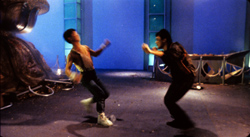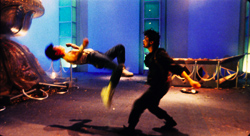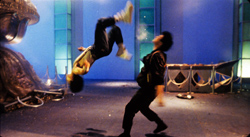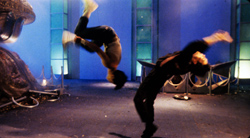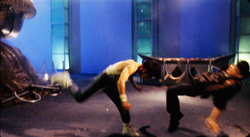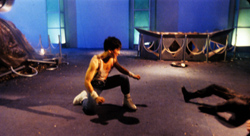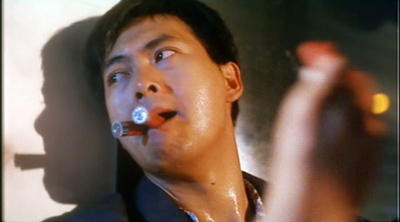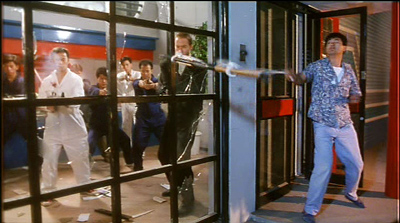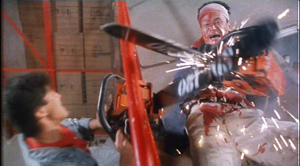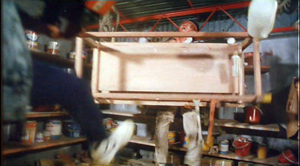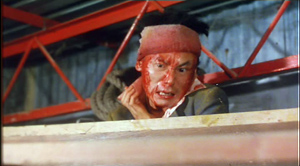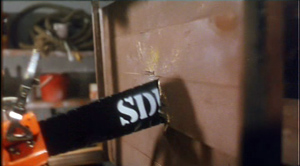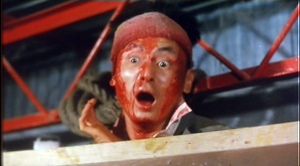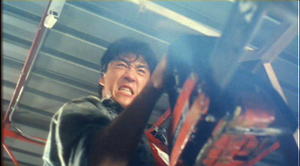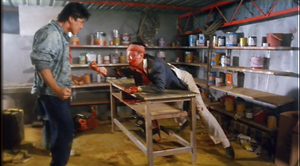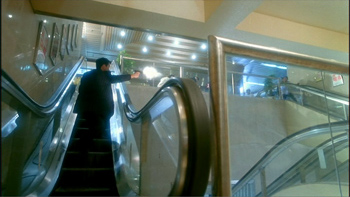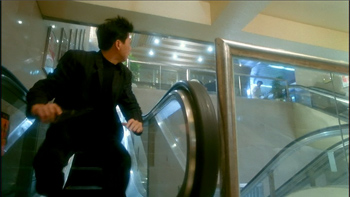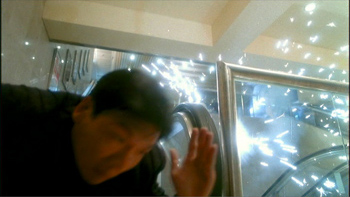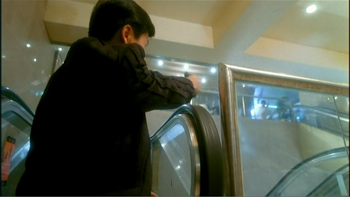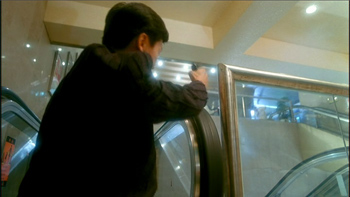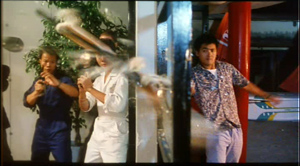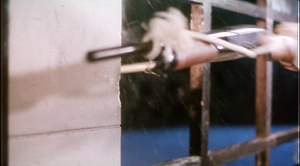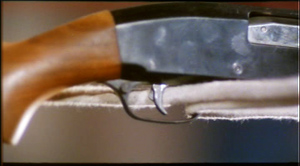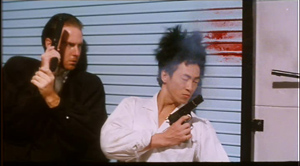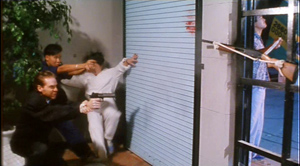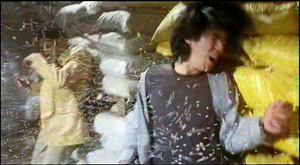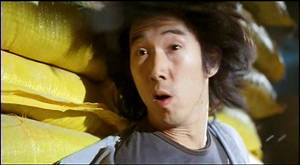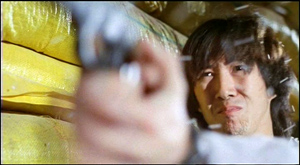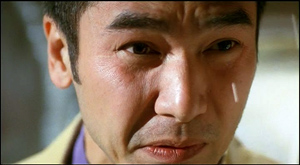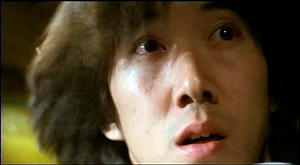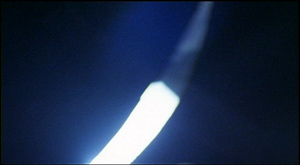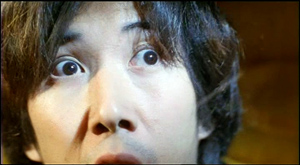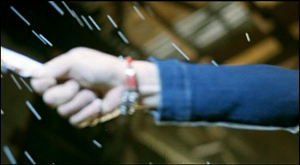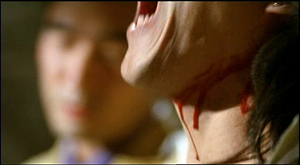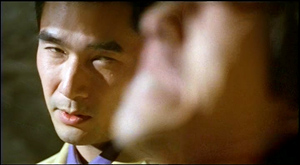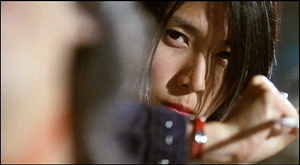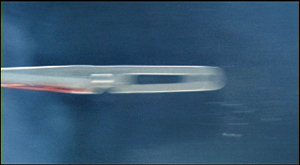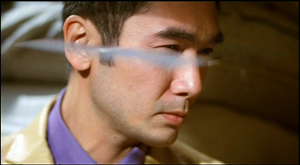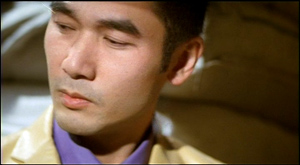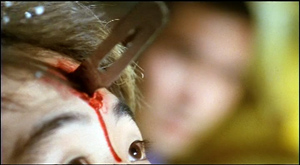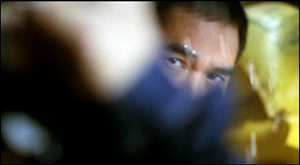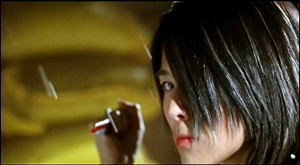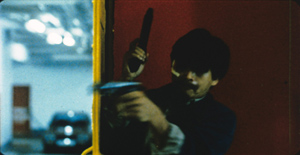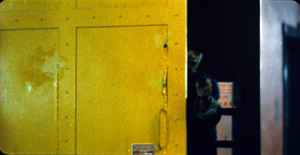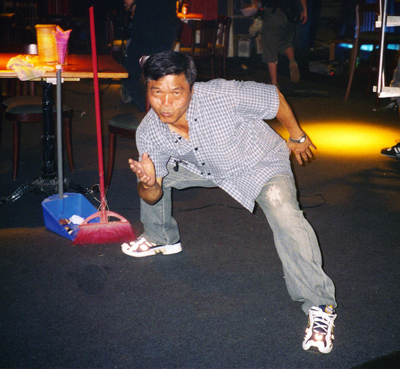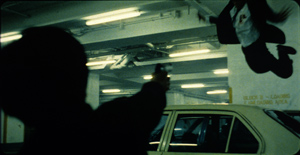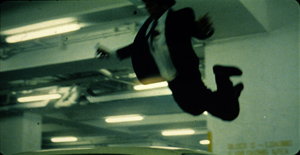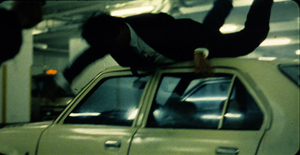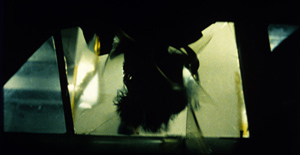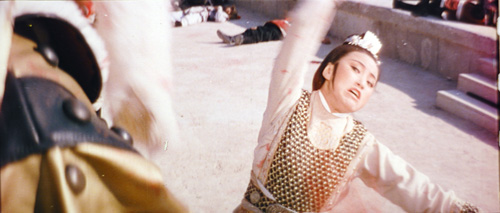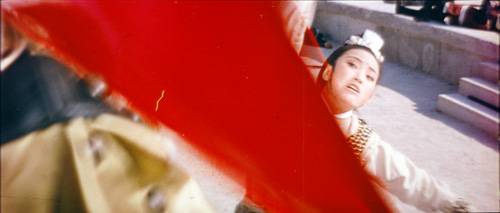PLANET HONG KONG: The dragon dances
Friday | January 14, 2011 open printable version
open printable version
The Iceman Cometh (aka Time Warriors, 1989).
DB here:
Planet Hong Kong, in a second edition, is now available as a pdf file. It can be ordered on this page, which gives more information about the new version and reprints the 2000 Preface. I take this opportunity to thank Meg Hamel, who edited and designed the book and put it online.
As a sort of celebration, for a short while I’ll run a daily string of entries about Hong Kong cinema. These go beyond the book in dealing with things I didn’t have a chance to raise in the text. This is the third one. The first, a list of about 25 Hong Kong classics, is here. The second, an overview of the decline of the industry, is here. The fourth is a photo portfolio showing some stars; it’s here. Then comes an entry on western fandom, a photo gallery of director snapshots, and finally some reflections on the value of film festivals, capped by a list of some personal favorites. Thanks to Kristin for stepping aside and postponing her entry on 3D.
The longest chapter of Planet Hong Kong deals with action films. Here are some further thoughts on this fascinating genre.
Four aces of action
Tiger on Beat (1988).
Directing any action sequence poses several tasks. Once the stunts are decided upon, I can think of at least four such tasks.
1. The filmmakers need to present the physical actions clearly enough for the viewer to grasp them. Who hits whom, and how? What did X do to duck Y’s bullet? Which car is pursuing, which one is fleeing?
2. If the fight or chase is to be prolonged, one needs to come up with a series of phases that take the action into different areas of a locale, or into ever more dangerous situations. The classic arc is a fistfight that pushes the combatants to the edge of a cliff or roof, with the protagonist about to be shoved over. In other words, the action scene typically has a structure of buildup.
3. An action scene can express the emotions of the fighters—perhaps wrathful vengefulness on the part of one, versus cold calculation on the part of the other.
4. Finally, the filmmaker might want to try for a physical impact on the viewer. Just as sad scenes can make us cry and comic scenes can make us laugh, action scenes can get us pumped up. We can respond physically: we can tense up, blink, recoil, twist in our seat, and so on. How can the filmmaker achieve the level of engagement that Yuen Woo-ping emphasized in an interview with me: “to make the viewer feel the blow.”
I think that 1 and 2 are basic craft skills, with 3 and 4 being measures of higher ambitions on the part of filmmakers. Not everyone agrees. Philip Noyce says that incoherence (i.e., lack of clarity) is no problem:
I don’t necessarily think the audience member is looking for coherence; they are looking for a visceral experience. If they want coherence they can watch television.
Put aside the last comment, which begs for a bit more explanation. Noyce goes on to suggest a common rationale for lack of clarity: if the action’s confusing, it’s because the character is confused too. He praises Paul Greengrass’s framing and cutting in the Bourne films because
. . . The camera was used for its visceral possibilities rather than its literal ability. We felt the chase from the inside, where sometimes disorientation becomes an asset because it’s all about the velocity. Sometimes the pursuer and pursued don’t know where they are in relation to each other.
Greengrass’s fans have employed a similar argument, not so far from Stallone’s claims about The Expendables. It seems that many contemporary directors have concentrated on the fourth task, and to some extent the third, the expressive one (but only if the fighters’ emotion is disorientation). Job 1, basic and clear presentation, has become less important.
Yet it seems to me that the contemporary blur-o-vision technique doesn’t create a very sharp or nuanced impact. In effect, filmmakers try to amp up our response through jerky cutting, bumpy camerawork, and aggressive sound (which may be a major source of any arousal the movie yields). The result often doesn’t depend on what the actors do and instead reflects what can be fudged in shooting or postproduction. But we’re wired to react quite precisely to the movements made by living beings, human or not. If the film doesn’t make those movements at least minimally clear, we’re unlikely to sense anything more than a frantic muddle.
Further, Noyce doesn’t consider the possibility that a vigorous visceral effect can be created in and through coherent presentation of the action. The choice isn’t either/ or. The Asian action tradition, especially as practiced in Hong Kong, shows that we can have the whole package, often in quite elegant form.
OTT is OK
The Hong Kong tradition is probably most evident in its resourcefulness in fulfilling Task no. 2: creating an escalating pattern of mayhem and hairbreadth escapes. Filmmakers have been quite inventive in dreaming up outlandish twists in the action. The climax of Tiger on Beat (1988), from master Lau Kar-leung, indulges in what fans would call OTT (over-the-top) stuff. Above, outside a shop selling sailboats, Chow Yun-fat uses a clothesline to snap his shotgun out and blast the gang inside—becoming a literal gunslinger. Stepping up the intensity, Conan Lee Yuen-ba gets to work in a chainsaw duet.
The striking thing is that such flagrantly loopy combat is quite exciting, even exhilarating, while the realism that Noyce and Stallone promote can leave us fairly unmoved. Lesson: Artificially shaped grace can be tremendously arousing. Don’t forget how people get carried away watching dancing, acrobatics, or basketball.
I’ve speculated that the blur-o-vision action style is popular in Hollywood partly because it can suggest violence without showing it, so the sacred PG-13 rating isn’t at risk. No such qualms afflict Lau Kar-leung, who shows the main villain pinned to a table by Lee’s chainsaw. OTT again.
Note that each shot is from a different camera setup, typical of the Hong Kong “sequence-shooting” method. In addition, the whole scene integrates many elements of the setting into the fight. You get the impression that a Hong Kong action choreographer, stepping into a barber shop or a hotel lobby, instinctively thinks: What could be a weapon? What offers cover if someone rushes in with a gun? The Tiger shop yields barrels of paint, chainsaws, and worktables that can collapse under a man’s second-story fall. Even more exhaustive (and exhausting) is the classic fight at the end of Bodyguard from Beijing (1994). Here Corey Yuen Kwai, locking his antagonists in a modern kitchen, makes punitive use of not just knives and cutting boards but also the faucet and dish towels.
So part of what engages us in Hong Kong action is the filmmakers’ inventiveness in finding new ways to develop the basic premises of fights and chases. But this Tiger on Beat sequence also gives us the action in an utterly clear and cogent way. Every shot is brightly lit and crisply composed, with vivid colors in the sets, like those slashes of red. The cutting, while fast, makes everything totally intelligible through matches on action, obedience to the 180-degree rule, and a rock-steady camera. On top of all this, the thrusts and parries are given emotional force through the antagonists’ gestures and expressions (furious, startled, agonized). So conditions 1 through 3 are satisfied.
After this scene, we might ask Philip Noyce: Visceral enough for you?
Cutting to the chase
Matters of clarity, buildup, expressiveness, and impact on the viewer raise the perennial debate among Old China Hands, Martial Arts Division. To cut or not to cut?
For some aficionados, the less cutting the better. In classic kung-fu of the 1970s the full frame and longish take let actors show that they can do real kung-fu. No need to fake it through editing tricks. Actually, though, these films are quickly cut. Directors of the period realized that if the action is cogently composed, you can edit long shots as rapidly as you can close-ups.
No doubt, there are powerful effects you can achieve in the single shot. Admirers of full-frame action can point to an escalator gunfight in God of Gamblers, in which one passage is ingeniously staged in a single deep shot. Ko Chun’ s bodyguard Lung Ng fires at his pursuer in the upper floor.
His opponent falls down the opposite escalator, but another comes up behind, glimpsed in an aperture of the railing, and he fires at Lung.
Lung rises from the extreme foreground to return fire, and in the distance we see his attacker fall out of the slot at the railing.
On the big screen, you can feel your eye leaping from foreground to background, zigzagging across the frame. The dynamism of the action is mimicked in the rapid scanning we execute in taking it in. The eye gets some exercise.
Still, editing can serve my four purposes too. Some of the disjointedness of modern action scenes, we tend to say, comes from the speed of the cutting nowadays. Yet fast cutting can be quite coherent. There are about 490 shots in the twelve-minute climax of Tiger on Beat; nearly all are from different setups, and some are only a few frames long. Since the classic Hong Kong tradition builds upon a commitment to clear rendition of the action, it can use cutting to highlight information or repeat it. At one point, Chow whips his shotgun around a doorway and yanks his rope to pull the trigger on men he can’t see. We get five shots in three seconds.
The shots run, in order, 10 frames, 8 frames, 10 frames, 16 frames, and 38 frames. (I’m a frame-counter.) The lengthiest shot is about 1.5 seconds and the shortest is 1/3rd of a second. Yet each bit of action is so pointedly presented that it’s impossible to misunderstand, while the pace of the cutting forces us to keep up.
At an extreme, we have something like Sharp Guns (2001), a very low-budget, somewhat smarmy actioner that creates two spiky moments out of close-ups. Tricky On, the leader of our hit team, is pinned down alongside a mop-haired thug.
The kid recognizes him and raises his pistol in big close-up.
On, in even tighter close-up looks off, and the kid follows his glance.
A nearly abstract blade slices into the frame and the kid turns, his face going wan from the glare of the metal.
A hand thrusts. A neck bleeds.
Rack focus to On. Cut to Rain, the female assassin. The unfortunate thug’s head in the foreground of each shot specifies where each one is.
The fragmentation intensifies when soon afterward a blade whizzes leftward into the frame. In the next shot it glides past Tricky On.
On follows it with his eyes. Cut to another thuggish head, on his other side, with the blade embedded.
Rack focus again as the body slides down. Cut back to Rain, who has again saved her boss.
We haven’t had a single establishing shot in this sequence. The play of glances and turning heads, along with occasional foreground elements, lets us instantly understand that Rain has protected On from thugs on his left and right. Kuleshov would be happy.
Sharp Guns is surely no masterpiece, and you suspect that the close-up strategy pursued by director Billy Tang Hin-shing was a cheap way out. But give him credit for ingenuity, for well-timed cutting and movement, and for keeping the shots steady and legible. (Handheld shooting would dispel the force of the passage.)
Strongly marked cuts can also contribute a decorative punch. In A Better Tomorrow (1986), Chow is again pinned behind a door, and Woo cuts as he pokes his pistol around the edge.
The burst of that yellow slab in the new shot, counterbalancing the dark red of the earlier one, becomes the pictorial equivalent of a muzzle flash. Wouldn’t you like a bold cut like this in your film?
The pause that refreshes
Choreographer Yuen Bun during the filming of Throw Down (2004).
These are pretty flagrant examples. More commonly, Hong Kong cuts serve to sustain a line of motion or break one off abruptly. Later in the Better Tomorrow gunfight, Chow swivels from one adversary to another, who comes sailing in from above. (Remember: Artifice isn’t bad. And John Woo was an assistant director to Chang Cheh, one of the gurus of the 1970s martial arts cinema. In those movies people fly all the time.)
Woo is famous for using slow motion, but here what prolongs the movement are the cuts. They continue the movement of the thug as he’s hit and starts to fall, but oddly they suspend him in time a bit too.
When he finally descends, the camera pans down with him as he lands on the car. The next shot completes the movement, putting us in the car as his head smashes through the window.
Like the Tiger on Beat sequence, this passage exemplifies what Planet Hong Kong calls the pause/ burst/ pause pattern characteristic of Hong Kong action scenes. In the shots above, the soaring thug enters the first shot 7 frames before the cut. The next two shots run 13 frames and 18 frames. Most interesting is the last shot, the one from inside the car. It lasts 62 frames, making it the longest in the series. 30 of those frames show the thug’s head crashing through the window, but the remaining 32 frames have no movement except for his swaying tie. The sequence has paused for a little more than a second, sealing off this bit of action.
Another editor might have interrupted this last shot while the head was in motion, but the Hong Kong pause/ burst/ pause principle creates a distinct rhythm. A moment of stasis is followed by a stretch of sustained movement, smooth or staccato, building to a peak; then another instant of stasis. This pattern contrasts with the unorganized bustle typical of American films’ sequences.
I think that the Hong Kong tradition has shown what benefits arrive when directors strive to fulfill the first three of my four action tasks. I don’t have time here to go further, but PHK argues that the first three goals form a basis for the fourth—a strong, deeply physical engagement with the action. This need not conform to standards of realism if it galvanizes our eye and accelerates our pulse. What Eisenstein dreamed of, filmmakers in Japan and Hong Kong achieved: a fusillade of cinematic stimuli that pull us into the sheer kinetics of expressive human movement. Through precise staging and cutting and camerawork and sound, these directors offered us not an equivalent for a character’s confusion (we live in that state much of the time) but a galvanic sense of what pure physical mastery feels like.
After writing this blog, I was reading Alex Ross’s fine essay collection Listen to This and came across his essay on Verdi, which in an aside (pp. 198-199) notes the pleasures of OTT unrealism.
Most entertainment appears silly when it is viewed from a distance. Nothing in Verdi is any more implausible than the events of the average Shakespeare play, or, for that matter, of the average Hollywood action picture. The difference is that the conventions of the latter are widely accepted these days, so that if, say, Matt Damon rides a unicycle the wrong way down the Autobahn and kills a squad of Uzbek thugs with a package of Twizzlers, the audience cheers rather than guffaws. The loopier things get, the better. Opera is no different.
For more on the construction of Hong Kong action scenes, see here and here elsewhere on this site. A fuller discussion is in Chapter 8 of Planet Hong Kong.
14 Amazons (1972).












